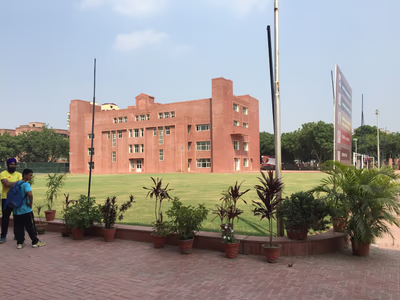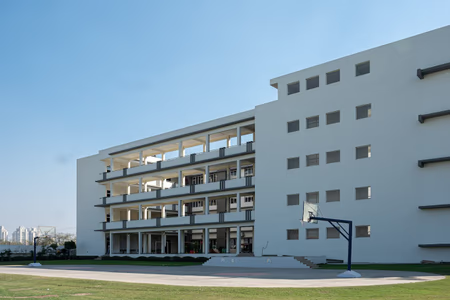
Gyaananda School, Sector 109, Gurgaon
Gyaananda School, Sector 109, Gurgaon Admission Enquiry
| Class | Session | Action |
|---|---|---|
Nursery | 2026-2027 | |
LKG | 2026-2027 | |
UKG | 2026-2027 | |
Class 1 | 2026-2027 | |
Class 2 | 2026-2027 | |
Class 3 | 2026-2027 | |
Class 4 | 2026-2027 | |
Class 5 | 2026-2027 | |
Class 6 | 2026-2027 | |
Class 7 | 2026-2027 | |
Class 8 | 2026-2027 | |
Class 9 | 2026-2027 | |
Class 10 | 2026-2027 | |
Class 11 | 2026-2027 | |
Class 12 | 2026-2027 |
Gyaananda School, Sector 109, Gurgaon Quick Facts

Board
CBSE
Gender
Coed
Classes
Nursery - 12 Class
Academic Session
April to March
Medium
English
Student Teacher Ratio
10:1
Day/Boarding
Day School
Gyaananda School, Sector 109, Gurgaon Fees Structure
Gyaananda School, Sector 109, Gurgaon Documents Required
Gyaananda School, Sector 109, Gurgaon Photos & Videos
Gyaananda School, Sector 109, Gurgaon Languages Taught
Gyaananda School, Sector 109, Gurgaon Facilities
Connect with Ezyschooling Counsellor
Prashant
+91-87xxxxxx64
English, Hindi
Fill in your details to view phone number
Gyaananda School
Parent & Student Reviews
Be the First to Review Gyaananda School
Your feedback matters! Help other parents make informed decisions by sharing your experience about Gyaananda School. Your honest review can guide families in choosing the right school.
Gyaananda School, Sector 109, Gurgaon Enquire About Admissions
Gyaananda School, Sector 109, Gurgaon Address And Contact
Near Dwarka Expressway, Sector 109, Gurugram, Gurgaon - 122006
Gyaananda School, Sector 109, Gurgaon About Us
Gyaananda, premium schooling facility in Gurugram (Dwarka Expressway), is a proposed (CBSE) senior secondary school with dynamic, progressive pedagogy aiming at creating a community of learners who embody the core of human values coupled with knowledge, skills, and competencies fundamental for today.
Our methods and techniques in classroom
Our aim is to foster learning environments where the child grows naturally but intellectually, by giving him resources that are crea[[ively stimulating and intellectually driven aiming at untapping the boundless possibilities of minds and energies of the young minds. The strategies behind planning classroom sessions are laid keeping in mind the following elements:
FACILITATOR LED LEARNING
Unlike a traditional classroom led by a classteacher, at Gyaananda there are facilitators facilitating learning in groups through activities and performances. The learning environment that is created through curiosity of children is rich with resources and learning tools that are actually run by the kids but managed by the facilitators. Facilitators are not information providers, they lead the path towards enabling learners discover the answers. It is not ready answers but awareness provided by the facilitators in the learning environments. The facilitator holds the hands of the learners in the journey of reaching the ultimate answers.
CO-OPERATIVE LEARNING
Cooperative learning or popularly known as group learning, is one that sparks engagement in classrooms by encouraging interaction among the students themselves. The facilitator, rather than calling on one student at a time, allows children to discuss class materials with buddies or in groups, thus maximizing the level of participation. The cooperative learning strategies as ‘Heart-Out Time’, ‘Sultan of Silly’, ‘Round Table Talk “, “what if…” narration are a few activities in which children, in team plays, let their imagination go vivid. Creating ideas, building upon those ideas, presenting those ideas in groups also develops multifaceted group dynamics and other team skills.
BLENDED LEARNING
In contrast to the traditional teaching of subjects or topics in isolation, ay Gyaananda one topic is touched at multiple levels covering multiple concepts and skills. A project or a problem or a question or a theme could form a base for a learning capsule which can be dealt through multiple touchpoints. For example: “a trash can full of trash” could have following touchpoints: General Science: types of trash (dry and wet), concept of recycle; Social Science: Helpers around us (garbage collector), , Communication: A narration or a role play woven around it, etc
Also, there are various ways of treating a topic for learning, for example:: face-to-face interaction, use of smart class aids, self created teaching aid, developing personalised content or computer mediated activities.
LANGUAGE RICH LEARNING
In Gyannanda classrooms, students’ exposure to language is deliberate, meaningful, repetitive, active and engaging. Building conversations, narratives and vocabulary through activities as ‘World-of-Words’, ‘Mr Victor Vocab’, ‘Grandma Tales’, weekly stage exposure through ‘Hamara Manch’ are a few of the many methods practiced for developing linguistic excellence at an early age.
Reading out loud teaches cadence of speaking- modulation, expression and inflection of voice.
Even handing over a jumbo book, touch and feel book or a picture book to kids for quiet reading time adds to imagination. Early years are the foundation that underpin speech and language development through such activities.
OBSERVATIONAL LEARNING
The best way to learn is to observe the world around. Observation leads to curiosity, curiosity leads to inquiry and inquiry leads to seeking the path of answers. Children can use their senses to to describe the properties of events and objects, such as what makes wind different from sunshine and rain different from snow. Facilitators have students classify objects according to their physical attributes such as size, length, weight, temperature, etc. Even at Pre-primary level, children are able to test hypotheses by experimentation, such as guessing what will happen when they combine two colors and observing the result.
It’s imperative to provide the environment that invites exploration for the young learners and further develops inquisitive minds. Questions are a sign of interest, a spirit of inquiry. They are required, they are unavoidable. Sawaal acche hai!
INCLUSIVE LEARNING
A standard and common learning environment is extended for young learners to meet the common goal of mass learning. Students with varied backgrounds and learning abilities come together in an inclusive environment where each student is provided sufficient level of support with student- centered teaching practices and principles. Gyaananda School takes it as a duty to accept each child and cater to social, civil and educational rights of children with special learning needs. Every child is valued equally and given same opportunities to learn and grow.
TEACHING & LEARNING THROUGH PRINCIPLES OF MULTIPLE INTELLIGENCES
There is no one size that fits all- Not every student learns the same way. Neither does every student has the same mental appeal, strength and ability. There are broadly 8 types of human intelligences, each representing different ways of processing information that are natural in a being. Everyone has all eight types of the intelligences listed in Gardener’s theory of Multiple Intelligences at varying levels of aptitude — perhaps even more that are still undiscovered — and all learning experiences do not have to relate to a person’s strongest area of intelligence.
A student skilled at learning new language may have a high verbal-linguistic intelligence but If that student is not exposed to other areas of mental development, eg: Logical- Mathematical, Visual- Spatial intelligence, etc his other intellectual faculties may not develop and slumber off to passivity. It is the school’s responsibility that the classroom models, pedagogy, assessments, etc are so diverse that they aid in kindling all the 8 domains of intelligence rather than pampering that one naturally dominant area of intelligence.
Gyaananda School, Sector 109, Gurgaon Parents also enquired to
Gyaananda School, Sector 109, Gurgaon Similar schools
Gyaananda School, Sector 109, Gurgaon Popular comparisons with
Gyaananda School, Sector 109, Gurgaon Claim School

If you are an authorized person on this school behalf and want to start accepting applications/enquiries through ezyschooling platform for admissions, please claim this school.
Disclaimer
Gyaananda School, Sector 109, Gurgaon FAQs
The average student-teacher ratio at Gyaananda School, Sector 109, Gurgaon is 10:1.
The total cost of admission in Gyaananda School, Sector 109, Gurgaon usually starts at Rs. 1,89,000 and can go up to Rs. 2,95,000. This includes: Security Fees, Tuition Fees, Admission Fees, Annual Fees, Other Fees & Transport Fees .
- Medical Room
- Art and Craft
- Dance
- Music
- Picnics and excursion
Currently, we do not have any conclusive information on the scholarships available in Gyaananda School, Sector 109, Gurgaon. Parents can direct contact the school for information on scholarships or fee reductions of any sort.
Gyaananda School, Sector 109, Gurgaon is affiliated with CBSE board(s).
The academic session at Gyaananda School, Sector 109, Gurgaon begins in April and continues through March of the following year.
Gyaananda School, Sector 109, Gurgaon was established in the year N/A.
No, applications for Gyaananda School, Sector 109, Gurgaon aren’t available on Ezyschooling. You can apply by visiting the school in person or using its official website. You can still use Ezyschooling to explore and compare schools that match your preferences. Alternatively, you can explore Ezyschooling to discover and compare schools that best match their preferences, even if applications for Gyaananda School, Sector 109, Gurgaon are not directly available through the platform.
























































